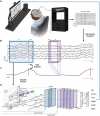Stable Decoding from a Speech BCI Enables Control for an Individual with ALS without Recalibration for 3 Months
- PMID: 37875404
- PMCID: PMC10724434
- DOI: 10.1002/advs.202304853
Stable Decoding from a Speech BCI Enables Control for an Individual with ALS without Recalibration for 3 Months
Abstract
Brain-computer interfaces (BCIs) can be used to control assistive devices by patients with neurological disorders like amyotrophic lateral sclerosis (ALS) that limit speech and movement. For assistive control, it is desirable for BCI systems to be accurate and reliable, preferably with minimal setup time. In this study, a participant with severe dysarthria due to ALS operates computer applications with six intuitive speech commands via a chronic electrocorticographic (ECoG) implant over the ventral sensorimotor cortex. Speech commands are accurately detected and decoded (median accuracy: 90.59%) throughout a 3-month study period without model retraining or recalibration. Use of the BCI does not require exogenous timing cues, enabling the participant to issue self-paced commands at will. These results demonstrate that a chronically implanted ECoG-based speech BCI can reliably control assistive devices over long time periods with only initial model training and calibration, supporting the feasibility of unassisted home use.
Keywords: amyotrophic lateral sclerosis (ALS); brain-computer interfaces; neural decoding; speech brain-computer interface (BCI).
© 2023 The Authors. Advanced Science published by Wiley-VCH GmbH.
Conflict of interest statement
The authors declare no conflict of interest.
Figures





References
Publication types
MeSH terms
Grants and funding
LinkOut - more resources
Full Text Sources
Medical
Miscellaneous
